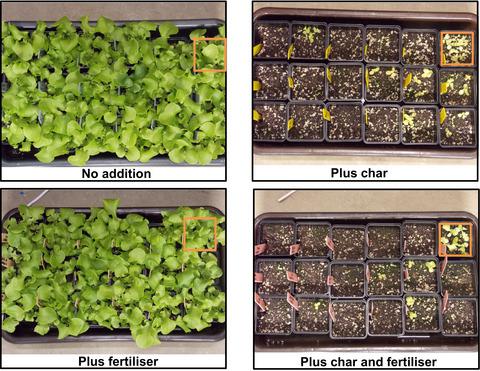当前位置:
X-MOL 学术
›
GCB Bioenergy
›
论文详情
Our official English website, www.x-mol.net, welcomes your feedback! (Note: you will need to create a separate account there.)
Evaluation of pyrolysis chars derived from marine macroalgae silage as soil amendments
Global Change Biology Bioenergy ( IF 5.6 ) Pub Date : 2020-07-24 , DOI: 10.1111/gcbb.12722 Jessica M. M. Adams 1 , Lesley B. Turner 1 , Trisha A. Toop 2 , Marie E. Kirby 2 , Christine Rolin 3 , Emma Judd 2 , Rhiannon Inkster 3 , Lesley McEvoy 3 , Waseem M. Mirza 2 , Michael K. Theodorou 2 , Joseph Gallagher 1
Global Change Biology Bioenergy ( IF 5.6 ) Pub Date : 2020-07-24 , DOI: 10.1111/gcbb.12722 Jessica M. M. Adams 1 , Lesley B. Turner 1 , Trisha A. Toop 2 , Marie E. Kirby 2 , Christine Rolin 3 , Emma Judd 2 , Rhiannon Inkster 3 , Lesley McEvoy 3 , Waseem M. Mirza 2 , Michael K. Theodorou 2 , Joseph Gallagher 1
Affiliation

|
Pyrolysis char residues from ensiled macroalgae were examined to determine their potential as growth promoters on germinating and transplanted seedlings. Macroalgae was harvested in May, July and August from beach collections, containing predominantly Laminaria digitata and Laminaria hyperborea; naturally seeded mussel lines dominated by Saccharina latissima; and lines seeded with cultivated L. digitata. Material was ensiled, pressed to pellets and underwent pyrolysis using a thermo‐catalytic reforming (TCR) process, with and without additional steam. The chars generated were then assessed through proximate and ultimate analysis. Seasonal changes had the prevalent impact on char composition, though using mixed beach‐harvested material gave a greater variability in elements than when using the offshore collections. Applying the char at 5% (v/v)/2% (w/w) into germination or seedling soils was universally negative for the plants, inhibiting or delaying all parameters assessed with no clear advantage in harvesting date, species or TCR processing methodology. In germinating lettuce seeds, soil containing the pyrolysis chars caused a longer germination time, poorer germination, fewer true leaves to be produced, a lower average plant health score and a lower final biomass yield. For transplanted ryegrass seedlings, there were lower plant survival rates, with surviving plants producing fewer leaves and tillers, lower biomass yields when cut and less regrowth after cutting. As water from the char‐contained plant pots inhibited the lettuce char control, one further observation was that run‐off water from the pyrolysis char released compounds which detrimentally affected cultivated plant growth. This study clearly shows that pyrolysed macroalgae char does not fit the standard assumption that chars can be used as soil amendments at 2% (w/w) addition levels. As the bioeconomy expands in the future, the end use of residues and wastes from bioprocessing will become a genuine global issue, requiring consideration and demonstration rather than hypothesized use.
中文翻译:

评估海洋大型藻类青贮饲料作为土壤改良剂时的热解炭
检查了青贮大型藻类的热解炭残留物,以确定它们在发芽和移植的幼苗上作为生长促进剂的潜力。大型藻类是在5月,7月和8月从海滩收集物中收获的,其中主要包含指骨海带和高海拔海带。天然播种的贻贝系,以糖藻为主; 和栽培有指状线虫的株系。使用热催化重整(TCR)工艺,在有或没有附加蒸汽的情况下,将材料压实,压制成丸粒并进行热解。然后通过近似分析和最终分析评估生成的炭。季节性变化对炭的成分有普遍的影响,尽管使用混合海滩采伐的材料比使用离岸采集的元素在元素上具有更大的可变性。在发芽或幼苗土壤中施用5%(v / v)/ 2%(w / w)的炭对植物普遍不利,抑制或延迟评估的所有参数,而在收获日期,物种或TCR加工方法上没有明显优势。在生菜种子发芽中,含有热解炭的土壤会导致更长的发芽时间,更差的发芽率,产生的真叶更少,较低的平均植物健康评分和较低的最终生物量产量。对于移植的黑麦草幼苗,植物的存活率较低,存活的植物产生的叶片和分till较少,切割后的生物量较低,切割后的再生较少。由于来自含炭植物花盆的水抑制了生菜炭的控制,另一项观察结果是,来自热解炭的径流水释放出有害于栽培植物生长的化合物。这项研究清楚地表明,热解大型藻类炭不符合标准假设,即炭可以以2%(w / w)的添加量用作土壤改良剂。随着未来生物经济的发展,来自生物加工的残留物和废物的最终使用将成为真正的全球性问题,需要考虑和示范,而不是假设的使用。
更新日期:2020-07-24
中文翻译:

评估海洋大型藻类青贮饲料作为土壤改良剂时的热解炭
检查了青贮大型藻类的热解炭残留物,以确定它们在发芽和移植的幼苗上作为生长促进剂的潜力。大型藻类是在5月,7月和8月从海滩收集物中收获的,其中主要包含指骨海带和高海拔海带。天然播种的贻贝系,以糖藻为主; 和栽培有指状线虫的株系。使用热催化重整(TCR)工艺,在有或没有附加蒸汽的情况下,将材料压实,压制成丸粒并进行热解。然后通过近似分析和最终分析评估生成的炭。季节性变化对炭的成分有普遍的影响,尽管使用混合海滩采伐的材料比使用离岸采集的元素在元素上具有更大的可变性。在发芽或幼苗土壤中施用5%(v / v)/ 2%(w / w)的炭对植物普遍不利,抑制或延迟评估的所有参数,而在收获日期,物种或TCR加工方法上没有明显优势。在生菜种子发芽中,含有热解炭的土壤会导致更长的发芽时间,更差的发芽率,产生的真叶更少,较低的平均植物健康评分和较低的最终生物量产量。对于移植的黑麦草幼苗,植物的存活率较低,存活的植物产生的叶片和分till较少,切割后的生物量较低,切割后的再生较少。由于来自含炭植物花盆的水抑制了生菜炭的控制,另一项观察结果是,来自热解炭的径流水释放出有害于栽培植物生长的化合物。这项研究清楚地表明,热解大型藻类炭不符合标准假设,即炭可以以2%(w / w)的添加量用作土壤改良剂。随着未来生物经济的发展,来自生物加工的残留物和废物的最终使用将成为真正的全球性问题,需要考虑和示范,而不是假设的使用。



























 京公网安备 11010802027423号
京公网安备 11010802027423号